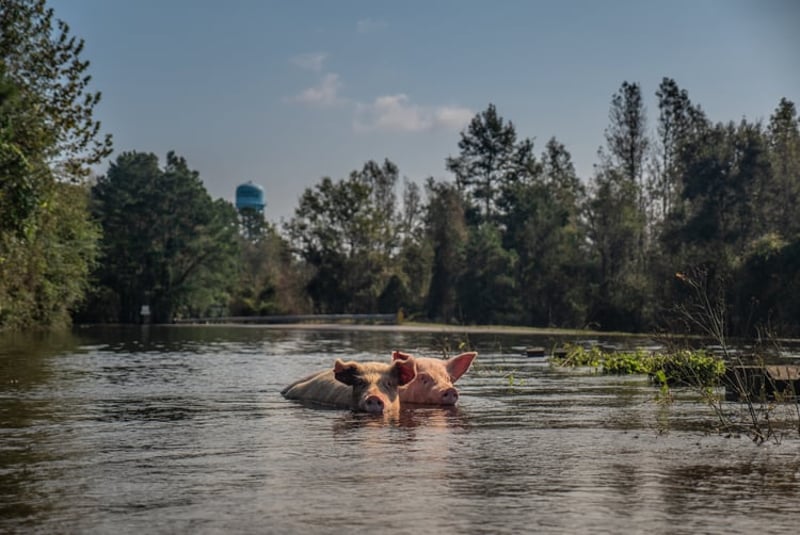
Protecting Farmed Animals in Natural Disasters: Why Governments Need to Act Urgently
Blog
Millions of farmed animals tightly confined in sheds across North Carolina were horrifically killed when Hurricane Florence hit in 2018. This grisly event proved that factory farms and governments are failing to protect animals when disasters strike.
In 2018, Hurricane Florence slammed into the East Coast of the United States, leaving widespread destruction in its path. With the Carolinas being particularly hard hit, the deaths of farmed animals left behind in locked cages and shuttered sheds skyrocketed into the millions.
It was reported that 3.4 million chickens and turkeys and more than 5,500 pigs died during Florence—even higher than those animal deaths reported when Hurricane Matthew decimated the same area a few years earlier. These animals drowned in the floodwaters or starved when food and water rations ran out or automated systems failed. An unknown number of animals suffered from injury and diseases following the storms and may have died later or been killed in order to be included in insurance claims.
While companion animals are mandated by law to be included in government preparedness and evacuation plans during natural disasters, farmed animals aren’t guaranteed those same protections.
Across the United States, more than 9 billion animals are raised for food each year, with the majority spending their miserable lives in cramped, filthy sheds. Pigs, and calves raised for veal, are forced to live in metal crates so small they are unable to lie down comfortably or turn around. Egg-laying hens are often confined to cages with other birds and have less space than the size of a sheet of paper in which to move. These animals suffer psychologically from their confinement and inability to perform natural behaviors like root, dust-bathe, and interact with their young.
When disasters strike, animals in factory farms are more vulnerable than animals on higher welfare farms. They face immense distress and suffering from poor housing environments, and a high likelihood of an inhumane death owing to their confinement. The compromised immunity of factory-farmed animals means they are less resilient to health risks that often accompany or follow disasters. In hurricanes and floods, for example, animals in factory farms are often exposed for long periods to disease-causing pathogens present in the manure-contaminated waters.
While regulations on the transport and slaughter of animals for food aim to prevent animals from suffering; drowning, starving, or slowly succumbing to disease or injury is nothing short of cruel. Farmed animals deserve our protection and to be afforded the best chance of surviving a disaster.
Animals on factory farms are treated as commodities rather than sentient beings deserving of protection, so the loss of their lives is viewed only in economic terms. State regulations and insurance policies may actively discourage farmers from implementing higher welfare measures and reward farmers for losing all of their animals to a disaster rather than saving them.
With climate change becoming a growing threat and factory farming being one of its biggest contributors globally, extreme weather events such as Hurricane Florence will continue. Farmed animals in the U.S. are concentrated in areas prone to strong hurricanes, tornadoes, floods, earthquakes, blizzards, and wildfires. Unless we act now, they will become increasingly vulnerable.
Having thousands of animals on one farm makes it impossible to design reasonable evacuation or mitigation plans. State governments must take action by ending the use of cages for animals, mandating higher animal welfare standards, and requiring a detailed disaster preparedness plan from every farm that includes limiting the number of farmed animals to levels where they can all be successfully evacuated in the event of an emergency.
We can’t do this without your help. Add your name now to our petition demanding governments set policies that protect these vulnerable animals today.
Header photo: Kelly Guerin / We Animals